Everything about this trip was a foray into the unknown. I had no idea Oki was a group of islands, and I never imagined each of the islands would reveal such a diversity of expressions. Oki is made up of two areas, Dozen and Dogo; and Dozen is further composed of three islands. The four islands are all different in topography, culture, and the character of the people.
The purpose of my trip was to be on the scene and witness Sony’s telecommunications system MADO form a connection between Oki Dozen High School, in Ama Town in the Dozen Islands, and Oki High School, on Dogo Island. The briefing was simple enough, and yet it didn’t leave me very clear about how the system worked, or why Oki was selected out of Japan’s thousands of islands, or what the significance was of connecting two schools in Oki rather than with a school outside the islands. Equipped with theses myriad mysteries, I headed toward the islands.
The most exciting part of traveling to an island is spotting its outline on the far side of the sea. You inch ahead toward the shadow looming like a lone wolf, step foot on the island, and instantly the people living there come into focus. On this trip, I was met at the port by Kazuhiro Nobe, director of the Oki Islands UNESCO Global Geopark Promotion Committee. The moment we were in his car, the passionate and motivated figure asked me, what is the first thing that comes to mind when I hear the word Oki? I said the first thing that came to mind at that moment was Oki was the place where Emperor Gotoba was exiled in 1221. He shot his next question like an arrow: Why do I suppose he was exiled to Oki? I did not have an immediate answer.
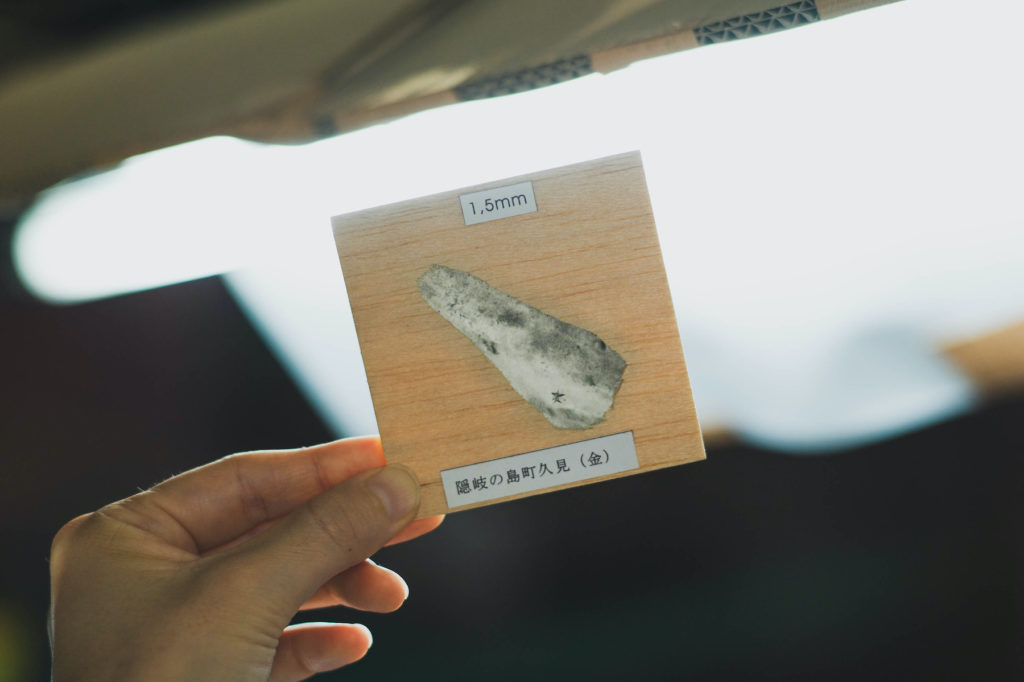
As we talked, it transpired that this project to connect two high schools in Oki via MADO started with the Geopark. Specifically, it started when Mr. Nobe met Yusuke Sakai, the developer of MADO at Sony.
“Connect” is the keyword of Mr. Sakai’s life. Connect people with people, place with place, and place with people. An avid traveler, Mr. Sakai’s joy in life is visiting various places and forming connections with the people he meets. Because his own life experiences formed the base of the MADO concept, he poured an extraordinary amount of energy into development. Mr. Nobe was keen to react to this passion.
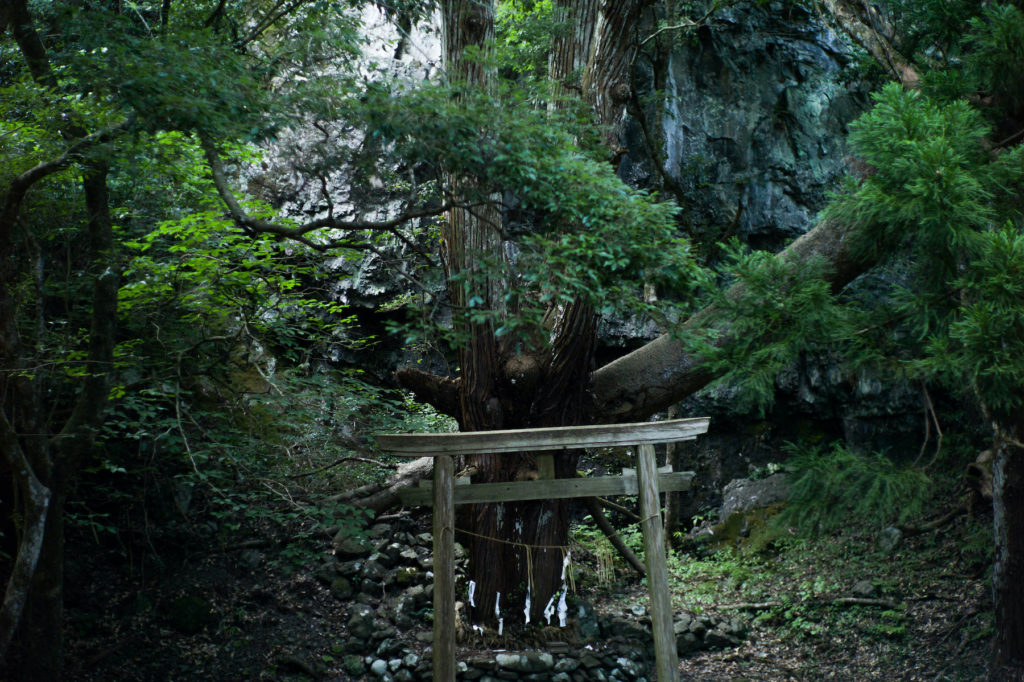
Mr. Nobe was born in Oki and found work in the town office’s construction division. All the while, he was frustrated. No one outside the islands seemed to know about the attractions of Oki. He would be talking about Oki, the islands of Shimane Prefecture in western Honshu, and more often than not, it would be mistaken for Iki, the islands of Nagasaki Prefecture in Kyushu. Recognition was incredibly low.
But come to think of it, Oki itself was partly to blame. There was very little interaction between the islands. An invisible boundary was drawn particularly between Dozen and Dogo, and the two areas had no common platform where they could work on something in collaboration.
If only there were a means of respecting the unique features of each island while promoting the attractions of the Oki Islands as a whole. This idea had formed in Mr. Nobe’s mind when he learned about the Geopark authorized by UNESCO.
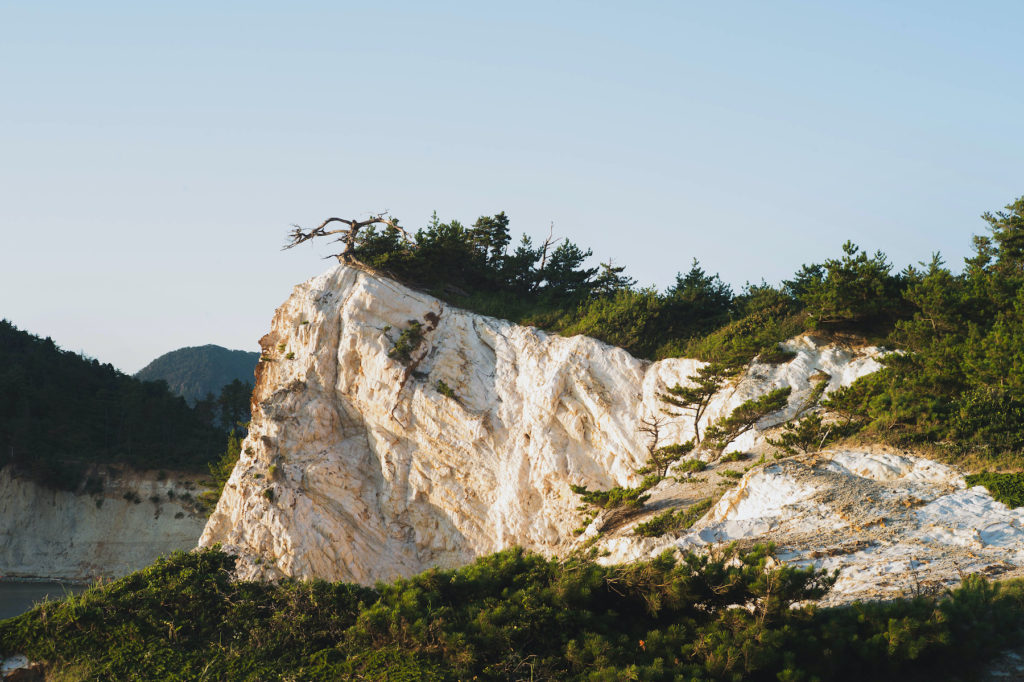
Oki boasts a unique natural environment. What’s more, the details differ from island to island and include many remarkable geological features. Just take a tour of the islands, and you’re guaranteed to find evidence. I came across strangely shaped rocks everywhere, for instance, and I noticed such dramatic changes in the color of rock and soil that I was under the illusion I had come to wonderland. These undulations of nature helped shape the people’s lifestyle, too. The shrines dotting Oki have preserved the traditional cultures rooted in the residents’ lives.
Truth be told, before I went to Oki, its history as a place of exile had given me the impression it was the dead end of culture. I am happy to say it was the complete opposite. The Oki Islands are a microcosm of the Japanese archipelago—stretching from east to west, mountainous, and displaying delicate expressions. I imagined Oki’s plentiful bounties of the mountain and the sea, and its rich culture helped establish close ties with the Imperial Family.
Mr. Sakai was also blown away by the facts the moment he visited the islands. He was all for using the MADO system as a means of promoting interaction between the islands and presenting the attractions of Oki to a global audience. This was the moment Mr. Nobe’s and Mr. Sakai’s ideals connected, and the two men joined forces to put the concept into practice.
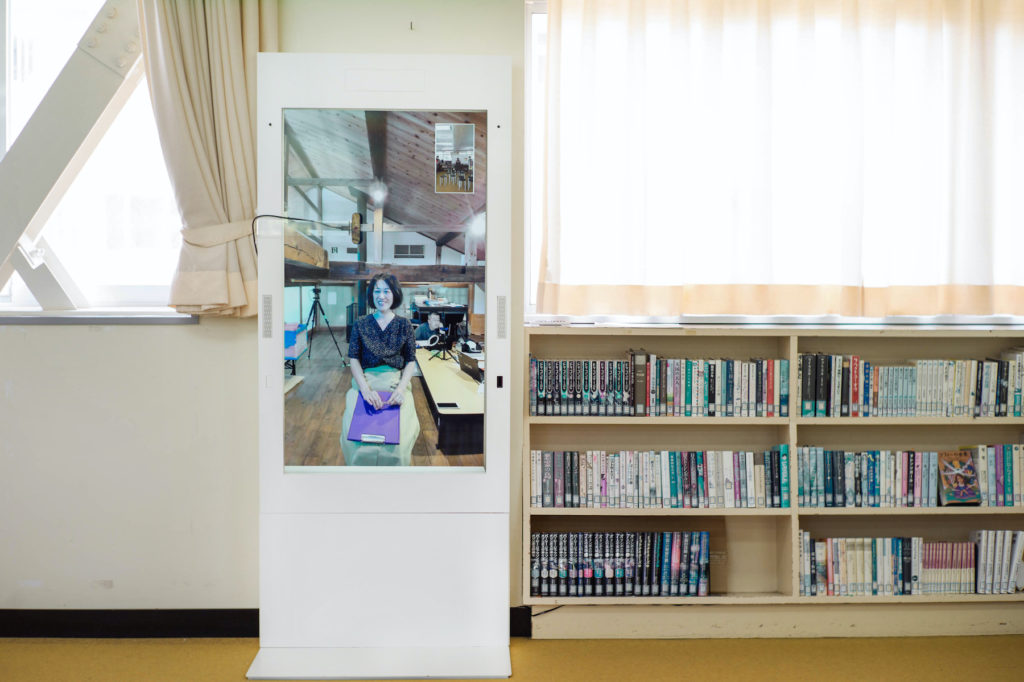
Here, let me offer a more in-depth explanation of the all-important MADO. Outwardly, it’s a 55 inch display with a camera attached. This is installed on the wall, and it literally looks as if a mado—“window” in Japanese—has opened up inside the room.
The COVID-19 pandemic has brought telecommunications systems like Zoom and Teams to the mainstream. MADO may seem similar, but it’s actually quite different. While the former systems are designed for sharing data between remote locations, MADO has no clearly defined purpose of use. It aims to connect multiple spaces with audio and visual, and to create the effect that the subjects in the monitor are there in reality. In the sense that the usage is not defined, it may be easier to think of MADO not as a product but as a concept.

MADO was set up in the two high schools that formerly had almost no interaction. The unit in Oki High School, on Dogo Island, was set up in the library, and the screen was connected around the clock to project the silhouettes of people coming and going, and relay the presence of people passing through the corridor behind.
A frequently asked question is, why is the monitor designed in portrait (vertical) and not landscape (horizontal) orientation? Portrait captures the ceiling and the floor, accentuating the perspective of the space. Landscape would cover a wider area but convey the space in less depth.
The camera is positioned in the center of the monitor. It is exposed and stationary. Moving the camera would explain the space and leave less to the imagination. Let’s say you’re looking through an actual window into a building. You see the furniture arrangement and human movement only within the confines of the rectangular shape, and this stimulates your imagination. If you were given more data, you would be distracted and lose interest. Because the system takes hints like this from a real mado (window), it makes perfect sense to name it MADO.
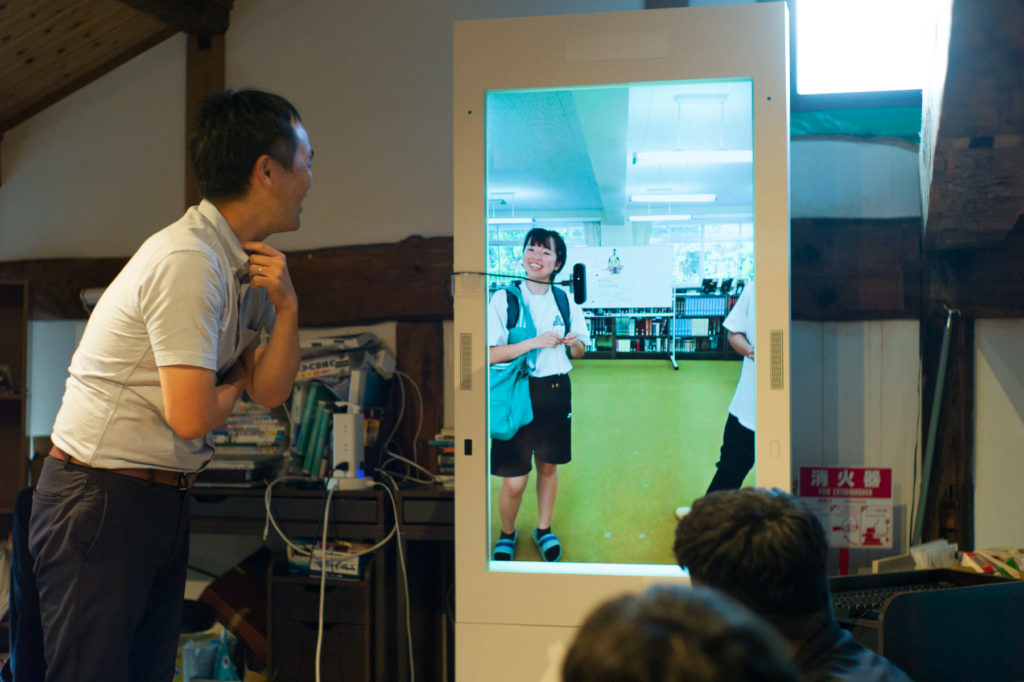
When adults come up against the unknown, we tend to brace ourselves and demand an explanation. Not high school students. They welcome anything that comes their way. If it’s boring they will walk away, and if it’s interesting they will come and look closer. The students in this project looked closer. I asked both schools about the students’ reaction two months after MADO was installed.
The unit in Oki Dozen High School was set up in a classroom for specialized subjects, where the doors are usually locked. The monitor is connected all the time, but a “curtain” function is turned on to blur the screen, and the sound is muted. A girl who came in for class glanced at the obscure image of the Oki High School library and made a funny gesture. Is anyone there? If you’re there, signal back. Seeing that she had struck up a silent conversation, other students gathered around and strained their eyes trying to make out any sign of a person in the blurry screen.
Something similar was going on at Oki High School. A student who noticed the silhouette of an Oki Dozen High School student across the curtain jotted down a message and held it up before the camera: “Are you XXX?” He had recognized the girl from an Instagram icon and tried to start a conversation in writing.
Children are more likely to approach their MADO when the curtain is drawn. You can’t quite see the person but you can feel a presence—they seem to be most comfortable with this sense of distance.
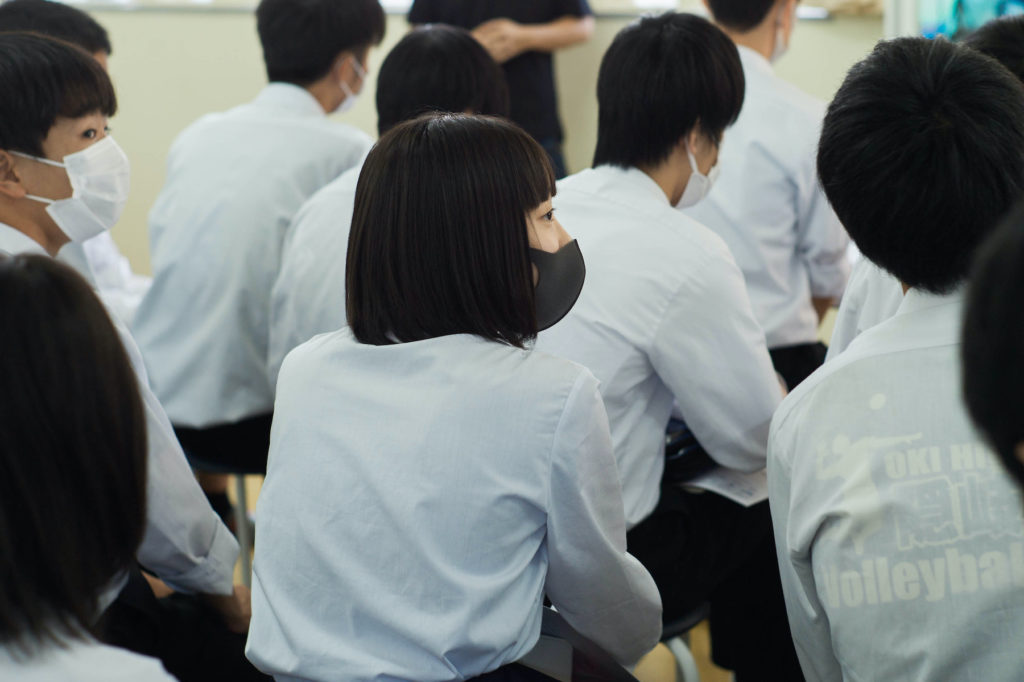
At Oki High School, Geopark studies is part of the curriculum. The full-time coordinator, Minamo Nobe, shared her insightful views.
Geopark activities had given Ms. Nobe a good deal of opportunities to meet students of Oki Dozen High School up to then. But only the same members showed up, and she hardly knew anything about the other students or the school atmosphere. MADO offered clues that helped her form a mental picture of Oki Dozen—this was what she had wanted all along. Every time she passed by the monitor, she unconsciously glanced at it and wondered what was happening on the other side. The two schools run on different timetables and play their chimes at different times. With each sound of Oki Dozen’s chime, she noted their start of a class period, or noticed the different tones of the two schools’ chimes. When the monitor’s lights were out, she pictured the school lights being out. She found herself tuning in to these subtle hints and feeling the air at Oki Dozen. The school that had only been a name until then was there in reality.
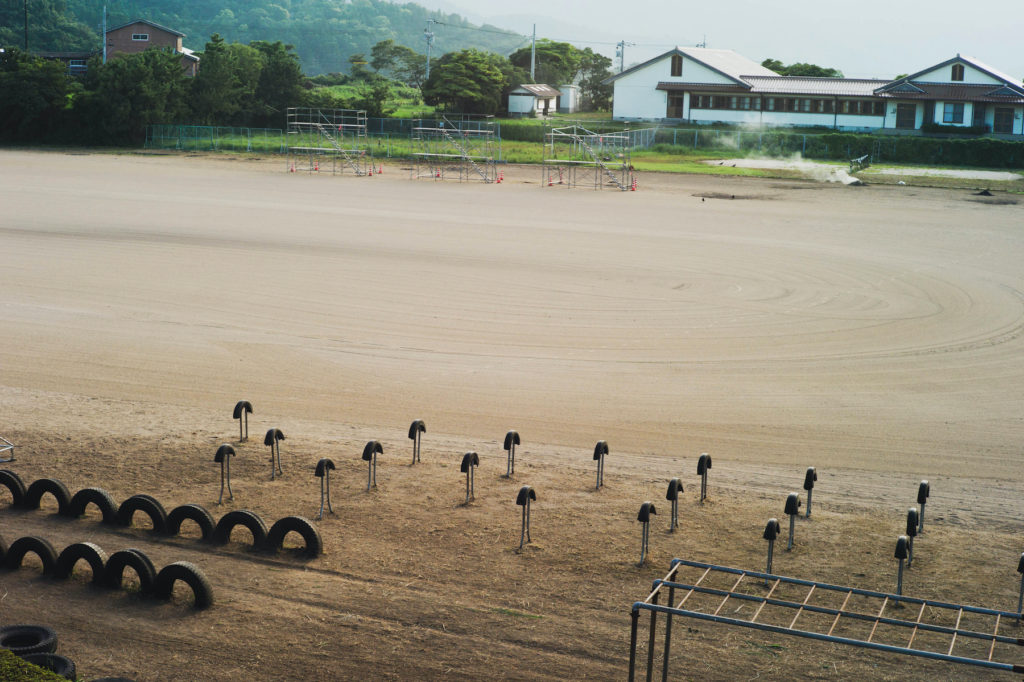
On the mainland, you run into students of other schools as a matter of course on your school route, at the bus stop, and by the neighborhood convenience store. On an island surrounded by water, such others simply don’t enter your field of vision. It’s only natural that the students in Oki found it difficult to imagine or develop an interest in others they couldn’t see.
Thanks to MADO, a connection was formed between two locations in Oki where there was hardly any contact before. Now the students can stand before their unit and peer through the “window” to see what is happening on the other side. Beyond promoting interaction with each other, MADO can connect the high schools with other islands and even locations outside Japan. When the time comes to explore other possibilities, the students’ experience of playing with the system like a toy, and not being bound by a defined purpose of use, will certainly prove valuable.
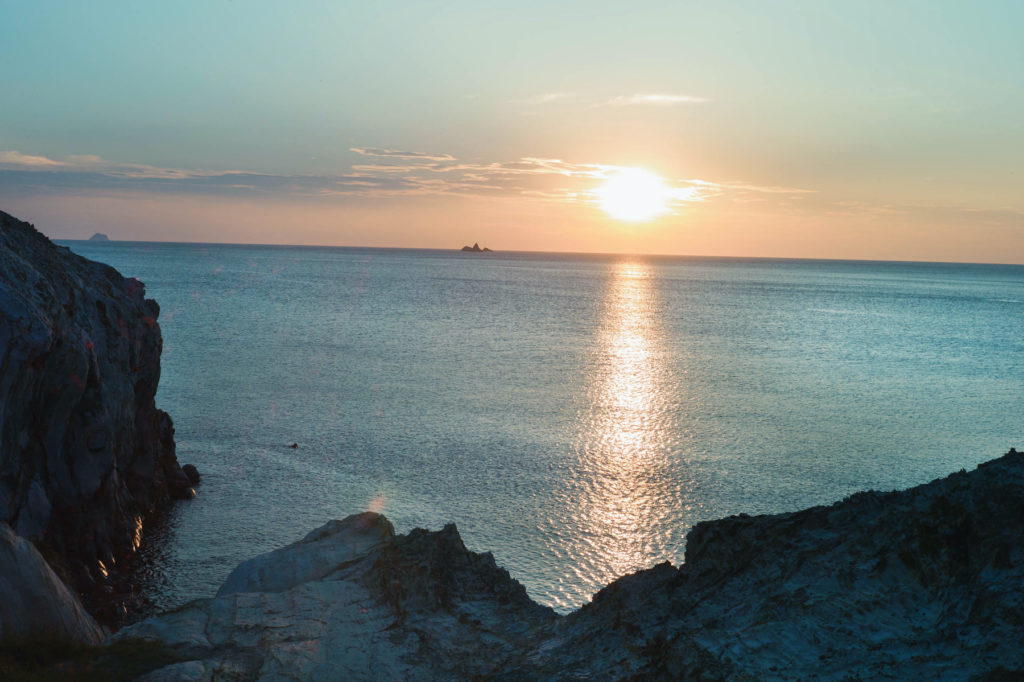
The COVID-19 crisis has forced many of us previously unfamiliar with telecommunication to organize frequent videoconferences and lectures and talk shows before a monitor. Recently I hear more and more complaints about those sessions feeling uncomfortable. In meetings with several people, you can’t tell when it’s your turn to speak. Having nothing to see but faces gives you a headache. You worry whether that person in the screen is even real …
What this tells us is that we humans don’t develop thoughts or feelings by focusing solely on the center of our field of vision. We touch the space and breathe the air. We do what comes naturally to humans and derive our words and actions from the entirety. Any serious attempt to connect people in remote locations must not neglect the air surrounding the person. Only when we grasp the space as a whole can we appreciate the real-life person living and breathing there.
In that sense, the development of MADO may be a never-ending quest of human nature. Having recognized the grandness of MADO’s mission, the anchor has been raised the sails set and MADO’s voyage towards the future has begun. Join us as we continue our epic journey.












